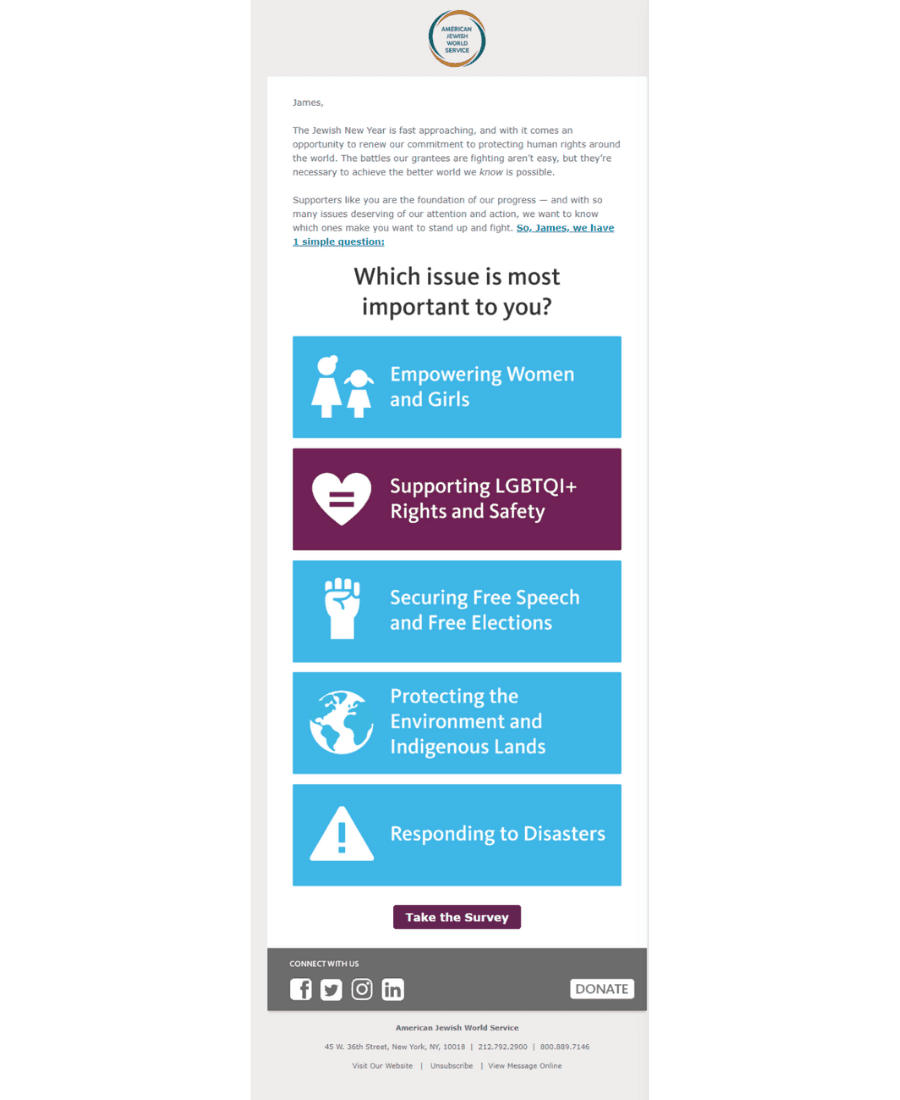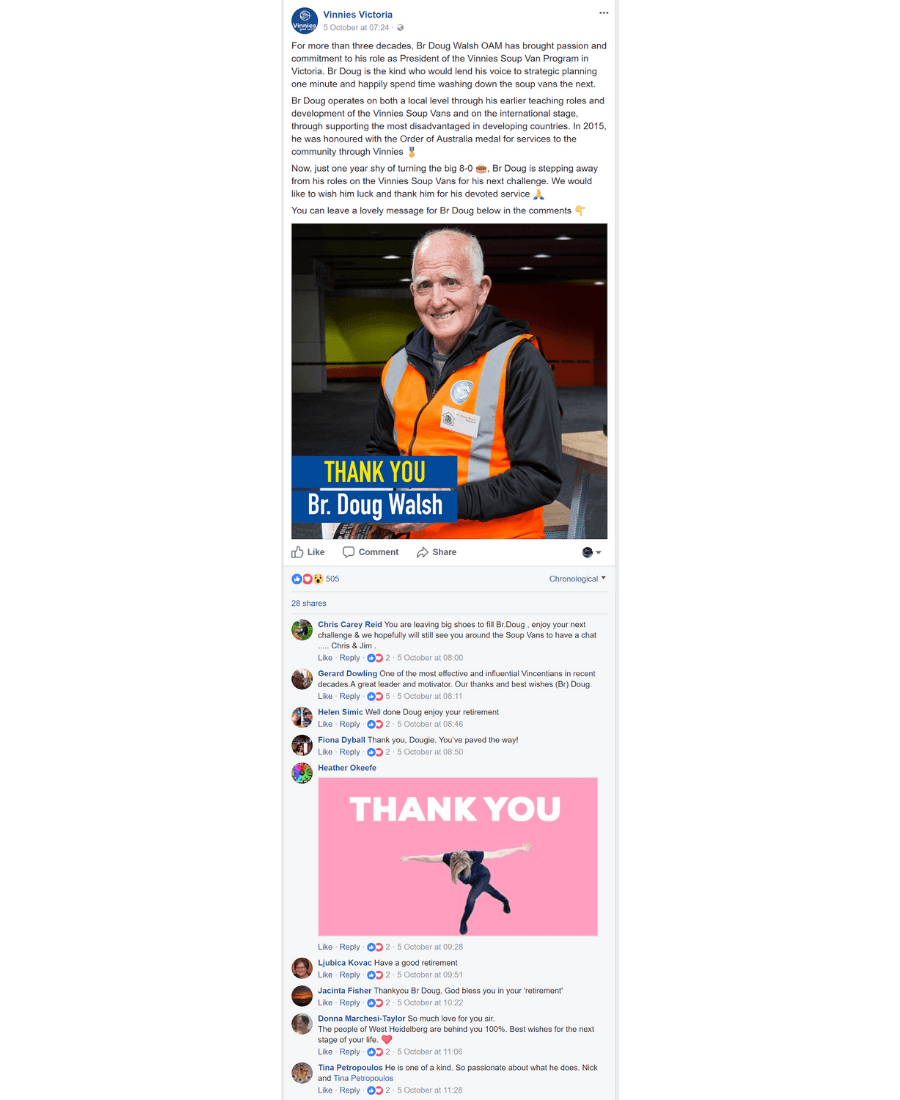Improve your supporters’ online experience to raise your fundraising results
James Herlihy of Dutch agency Mindwize shares his essential steps for avoiding a poor online experience for donors. He also gives his advice on how to power yourself to fundraising success.
- Written by
- James Herlihy
- Added
- July 07, 2022
If you want to grow your online fundraising in 2022, you need – or need plans for – a large, loyal, and engaged online community.
This online community includes people who interact with your website, as well as your social and multimedia channels. But the segment with the greatest fundraising potential is your first party data – the names, email addresses, phone numbers, etc. that you collect and hold in a database.
Lead generation – or meaningful online engagement – is the healthiest way to consistently build your base of online first party data in a scalable way. Online actions such as hand-raisers, value exchanges and petitions allow your audience to engage with your mission and values in a meaningful, cause-related way – and so are an excellent gateway into supporting your organisation.
More non-profits are testing and building skills in lead generation every year. But while this is encouraging, it’s been accompanied by the rise of a couple of major problems that limit both the experience of the supporter and the long-term fundraising outcomes of the non-profit:
1. A short-term, transactional approach to supporter growth
2. Poor ongoing digital engagement programmes.
Let’s dig a bit deeper into these pitfalls, then I’ll show how I believe you can deliver an awesome supporter experience and achieve maximum fundraising success.
Problem: Leads as single use commodities
Fundraising is important to all non-profits. Raising more funds means delivering your programmes to more beneficiaries and achieving more positive impact.
But some fundraisers seem to interpret that the best strategy to achieve this objective involves the simplest, least involved route for themselves.
In the case of two-step donor acquisition – (1) lead generation to (2) donor conversion – this often manifests as new leads being called a number of times for a donor conversion ask, and those that aren’t reached or converted being forgotten, never hearing from the organisation again.
This signals to prospective donors that you don’t care about them and is not a trademark of fundraising or good supporter engagement.
Let’s say you do the right thing and do keep speaking to your new leads – including the ones that don’t donate to you immediately. What do they experience from that point onwards? Is it going to inspire them, evoke their emotions and, ultimately, a financial commitment?
Sadly we often see non-profit communications that aren’t as excellent as the causes they represent, and so aren’t as likely to raise funds as they should be. Focusing on email communications and organic social content, we can identify five common problems:
1. Stiff, corporate communications: these feel like they’re written by an organisation rather than a real person. They use sector jargon, comms team-approved messages that the organisation wants to push out (rather than what the audience wants to hear), and branded design. They can feel like a brochure.
2. Lack of genuine, personal storytelling: humans are conditioned to communicate through and respond to stories. It’s hard-wired into us. Our brains can engage with big numbers, programme information and analysis, but that requires more effort to compute and stimulates reflection rather than action. The semi-engaged audience is far less likely to respond to it.
3. Lack of two-way conversation: with social media, blogs, online surveys, polls, hand-raisers and more, opportunities to offer interaction and to listen to our supporters abound. But many non-profits fail to seize these opportunities, talking only at supporters rather than with them.
4. Lack of variety in communications: to build engagement, stronger relationships, trust, and donor conversion of your audience, you need a mix of different types of content, message and ask. When a non-profit sends out just one type of content – just email appeals or just a monthly newsletter – it can lack depth and the variety needed to take the audience to higher levels of commitment.
5. Lack of personalisation: personalisation involves reflecting the things that people have told you, done with and for you in the past. It builds the sense of ongoing commitment, trust and relationship between you and the supporter. It isn’t always easy to execute but failing to try is a sure-fire way to limit your supporters’ engagement and response to your asks.
OK enough of the problems! Let’s move onto the solutions and some examples of non-profits doing it well.
Solution: Relationship fundraising
When someone signs your petition, takes your survey, or downloads your resource, they are signalling an alignment with your cause and values and openness to engage. This is a profound event. From here, you have the opportunity to build a rich, long-term relationship that gives the supporter deep fulfilment, reinforces their identity and delivers funding and more impact for your cause.
There’s no problem with giving an early supporter the opportunity to donate via an online ask or phone call. But don’t see this as a singular fundraising make or break moment.
To put some concrete under this idea, a few years ago I led a study on long-term lead conversion with Bush Heritage Australia, an organisation we were working with on two-step campaigns.
At the time we were running a number of cause-related surveys for Bush Heritage Australia to acquire leads, and we put these through a six-week journey of emails and telemarketing. Whether or not they converted during this initial journey, all leads then entered an ongoing engagement cycle of quality newsletters and appeals.
In two and a half years, looking just at new leads previously unknown to Bush Heritage Australia, we had converted 1,753 monthly donors and 686 single donors through the initial conversion journey. Not bad. But when we looked at the longer-term picture, we found that secondary monthly donor conversion (first donations made after the initial conversion journey) increased by 58 per cent to 2,762 monthly donors, and secondary single donor conversion increased by 61 per cent to 1,107 single donors. And this was just two and a half years after the lead generation campaign began – it’s certain that there has been further secondary donor conversion in the three years since.
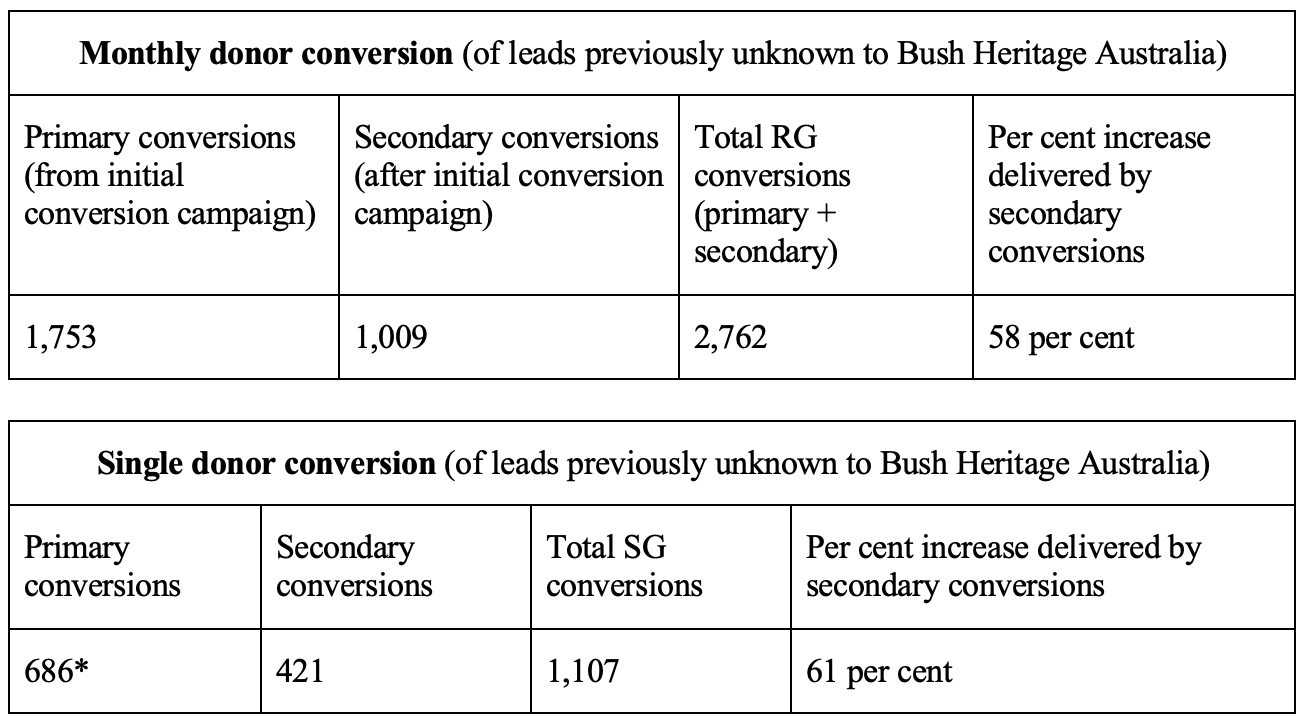
How did Bush Heritage Australia keep converting those leads after the initial attempt? Around 25 per cent were converted through a secondary calling programme. But the other 75 per cent came through plain old good email engagement.
Solution: A varied ongoing program of genuine engagement
Here we break down four attributes of an ideal engagement programme. We’re thinking mainly in terms of email – still the primary digital direct response channel for most non-profits. But these pillars of online communication apply across channels like social media too.
1. Two-way conversation, not one-way communications
If you want to build a relationship with someone, you need to engage them in conversation and reciprocity; both sharing and listening to perspectives. This is as true for organisations as it is for individuals. It’s the hallmark of the engagement approach to supporter relationships.
It’s not hard to incorporate more conversation and engagement into your programme. It just requires a change in thinking for organisations with a well-established broadcast communications culture.
The American Jewish World Service (AJWS) is a study in offering interaction and engagement to their community. The email below asks the reader to share which issues are important to them, driving to a simple landing page that receives the response.
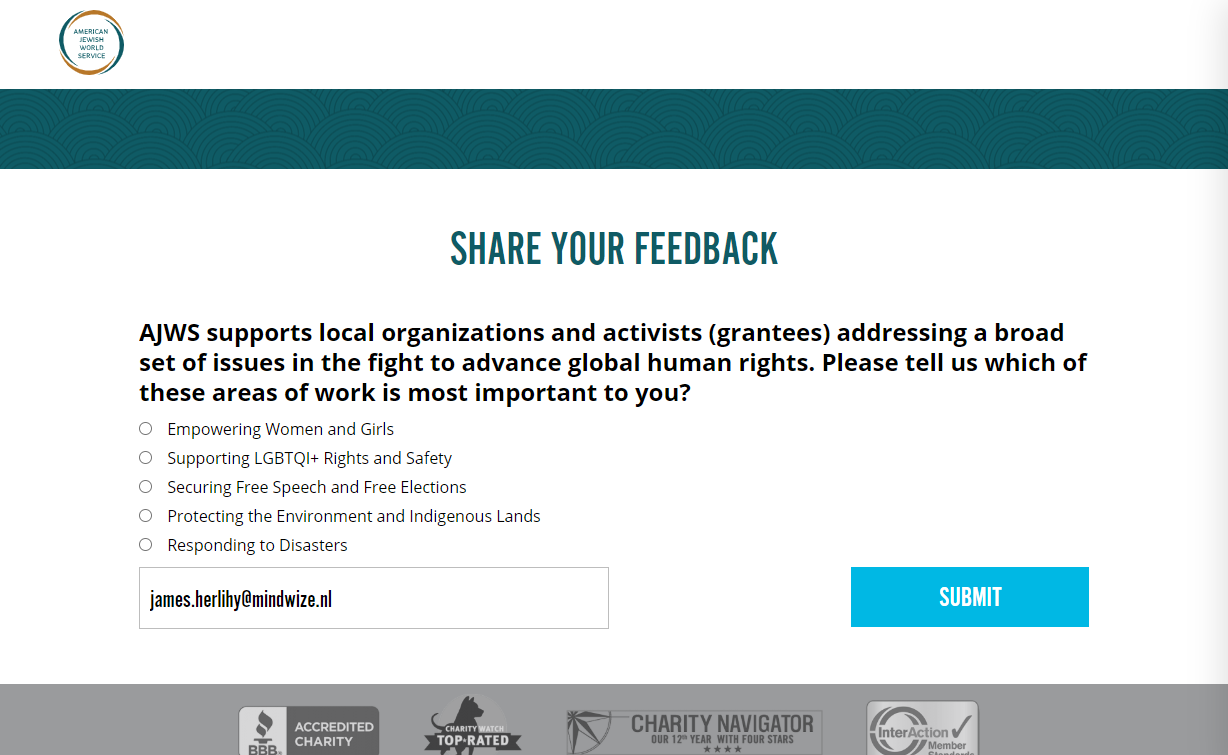
At Mindwize we often brainstorm and develop opportunities for community participation with our non-profit clients. These can be simple, like the ParkinsonFonds (Parkinsons Foundation) Netherlands poll below, which allowed participants to vote on which photo they’d like to see on the next yearly calendar. The calendar with the most votes was printed and then offered to the community.
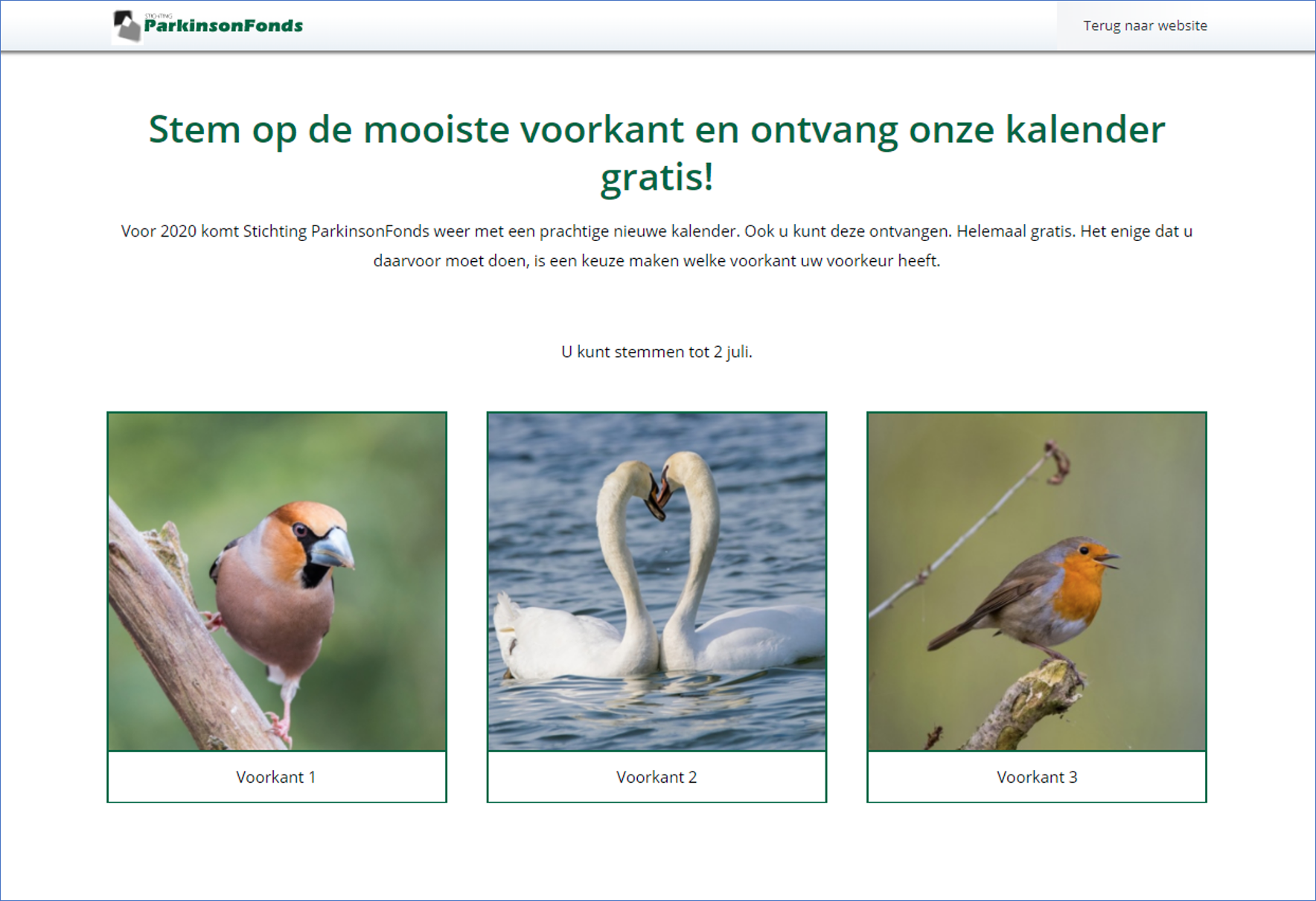
A Trombosestichting (Thrombosis Foundation) campaign used a similar mechanic, but with a multi-step process. The community was first asked to design a sock for the competition – a high-barrier ask that received a limited (but viable) number of entries. Then, after a shortlist of sock designs was created, we went back out to the community and asked them to vote on their favourite design – a lower-barrier ask that attracted much broader response. As a final step, the winning socks were produced and offered for sale, attracting solid proceeds due to the community engagement in the campaign.
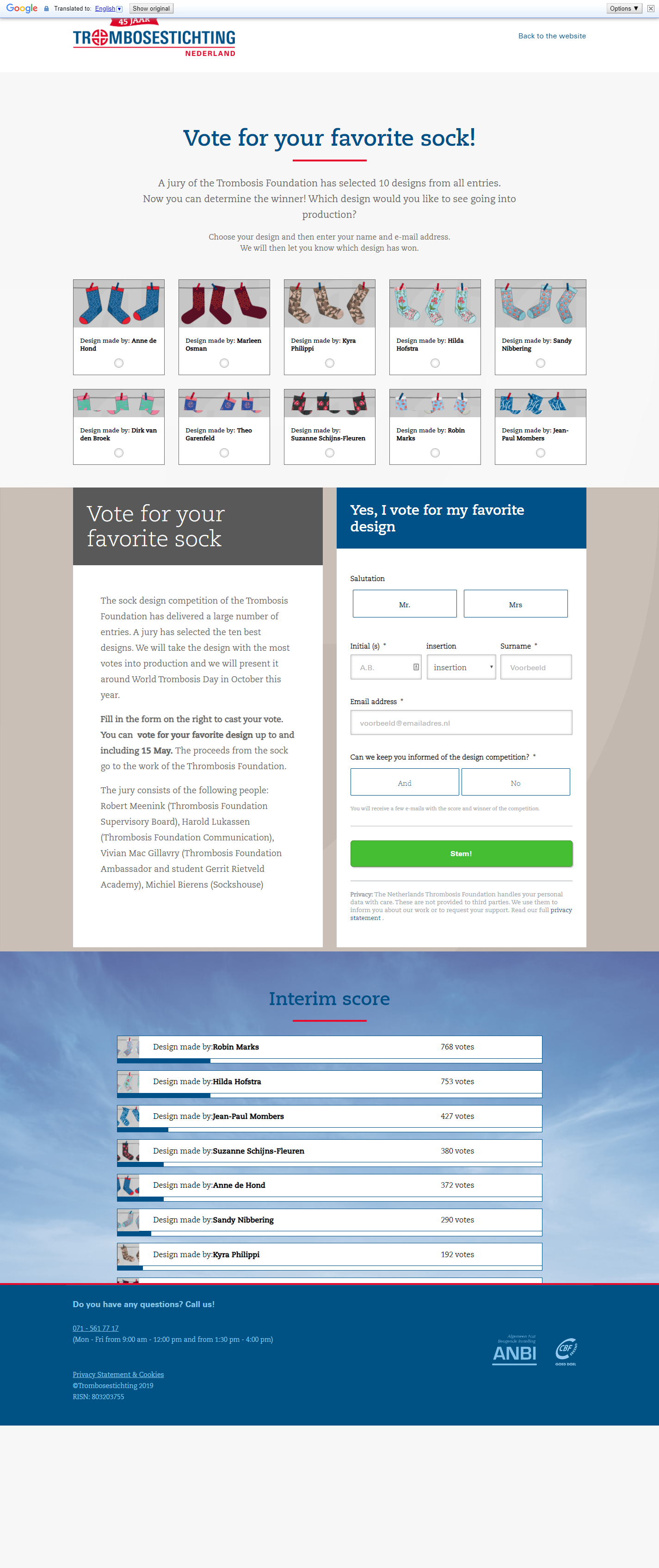
Offering genuine community engagement doesn’t have to mean building a complex campaign with bespoke landing pages. Social media lets us offer our communities engagement and conversation frequently on a small scale. The examples below from Vinnies Victoria invite supporters to celebrate (a) an inspiring hero figure and (b) their pets; both subjects that people love responding to, as evidenced by the replies.
2. Personal, story-driven content
Since we developed speech, humans have communicated through stories. We’re conditioned to respond to a personal anecdote that’s urgent, interesting, or shocking, something about people we know (or know of), or that represents an offer or opportunity. And if the story is well-told, we’re more likely to stay engaged and step deeper into it.
The World Vision blog screenshot below [1] was published in 2014 but is an evergreen example of excellent storytelling. In case you’re reading on mobile, here’s an excerpt:
‘Nasrella is a sweet 10-year-old boy with a kind disposition. He is softly spoken with a warm smile. He’s shy, yet brave. He’s scared, but thankful – thankful to live in a tent in Lebanon’s Bekka Valley, as long as it’s far away from the bombs and shelling he witnessed back home in Syria.
... Since leaving Syria, Nasrella hasn’t been to school. “What do you do with your days?” I ask. “We play… we just play,” he answers. He has no toys. But he does have three friends and you can tell their bond is tight.
Back home, he had 11 close friends. One of these friends is here with him now… “Only Hussein came with me from Syria,” he says. “What about your other friends?” I ask. “I don’t know where they are, I don’t know if they are ok – I don’t know anything about them.”
Nasrella is the apple of his mother’s eye. He’s the youngest, and back home in Syria had merit awards, which is he is shy to talk about yet also proud. “They gave me a merit award because I was smart and very good at school,” he says humbly. At school, he liked mathematics, specifically algebra. “I miss it so much, because I want to learn,” he says. It’s a story that’s all too common. “I want to teach little children.” He has the perfect demeanour to teach children. Despite all he has seen, he has such a gentle, kind manner. He smiles when he talks of his father, who he misses greatly. The family haven’t had contact with him in seven months, and they fear the worst.’

This powerful copy is heavy on quotes from the subject, even leading with one in the headline. It’s descriptive, giving you a strong feeling of Nasrella’s personality, story and living conditions. The reference to Nasrella’s father, whom he misses greatly, and hasn’t heard from for seven months, drives home the horrific impact of the Syrian conflict on families in an emotionally powerful way that we can relate to. Nasrella’s words about missing school and wishing to learn also relay this terrible human impact in a way we can relate to – and that relates to World Vision programmes.
In terms of style, the sentences are easy to read – not too long and using simple language. They feel like they’re written by another human rather than an organisation; the latter being an abstract thing that naturally speaks a different language to real people. And the photo of Nasrella is direct and untreated, showing a real boy in his real environment.
This story will deeply connect with more people and stay with them longer than an article about the scale of the crisis and World Vision programmes. It’s more likely to attract donations as well.
3. A healthy mix of content types and engagement offers
The best engagement programmes – and the ones likely to get traction with the broadest audiences – offer a variety of content and opportunities for the community to participate.
This makes sense. Maria may have the means to donate to you now and be ready to do so – if presented with a compelling reason and ask. Sara on the other hand may not be able to donate right now but may raise thousands for you from her peers – if you present her with an awesome-sounding event and help her with fundraising tips.
And Bill may not respond to direct appeals but may think of your cause when he wants to make a donation in honour of Mother’s Day – because you’ve regularly engaged him with relatable stories that build emotional connection and trust.
Beyond these fundraising cases, your online community will help you spread your news, lobby politicians, clean up beaches, deliver meals and achieve impact in a whole lot of other ways.
Try to build in a mix of great stories, non-financial interactions, different appeal propositions, community fundraising opportunities and more to your social media and email programmes – of course supporting the key themes you’re focusing on strategically but making sure this is always done in a supporter-centric way. The example cycle below focuses on email for simplicity and may represent two to three months for a reasonably well-resourced organisation.
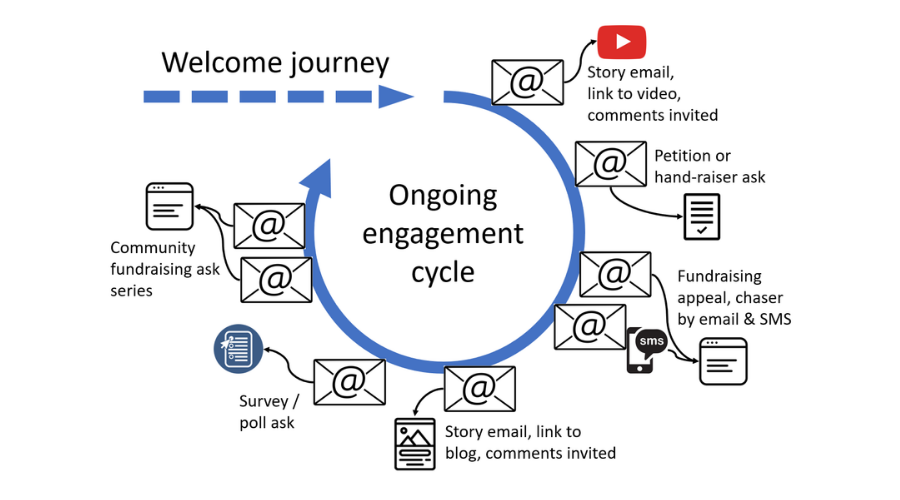
Of course, when you’re small, you can’t do it all. Non-profits with limited staff and resources need to pick and choose to an extent. But new tools are coming out all the time that make creating and publishing different types of content and interaction easier. And even small organisations can follow the principle of varying content and opportunities to participate – and increase the sophistication of their programs as the audience size and revenue increase.
4. Personalisation
If we’re really engaging our community in conversation, asking questions is just part of the picture. We then need to respond to what our people tell us and what they do for us. This is the essence of personalisation, and doing it well can brighten a supporter’s day, get them more engaged and help build their sense of relationship with you.
Personalisation is mainly relevant to your direct communications channels like email, although you can segment audiences in some organic social channels (like Facebook) to some degree. There are generally two levels on which you can personalise content to an individual:
1. What types of content and asks you send to them, for example news and appeals about certain themes they’ve responded to before.
2. What you include in that content, for example references to things they’ve done with and for you in the past, including what they’ve donated to.
Personalisation requires good planning and strategy, a strong understanding of your audience, creativity, the right, clean data, and great implementation to execute well. And if you’re going to do it, do it well so it has an impact on the reader, or forgo it for now and focus on nailing your communications as per the previous three points.
Here’s an example of personalisation that would lift the engagement of the reader and be a great step in strengthening relationship and commitment:
‘Good morning <James>, how are you? I wanted to reach out and thank you again for <donating to our Pacific Islands climate fund> in <March>. Your commitment to <local communities impacted by climate change> is having a real impact. As Nooroa, a fisherman from the Cook Islands, told us …’
Here’s an example of personalisation that’s less impactful:
[One-time donor:] ‘Thank you for your commitment to …’
[Monthly donor:] ‘Thank you for your great commitment to …’
I’ve seen this kind of personalisation many times in copy decks, and to me the addition of ‘great’ (or other adjective) doesn’t do much to grab the attention of the monthly donor. They don’t see the copy for the single donor and realise that they get some extra recognition. But it does take extra work to implement variables like this.
Don’t be overwhelmed; start with the foundations
If you’re early in your journey of online community growth, don’t be overwhelmed. It’s a process of continuous improvement for all organisations, including the big ones. You can start small, learn, and grow.
Just make sure you build on the right foundations. Recognise the commitment of every person who engages with you online, and the potential of that relationship to deliver a lifetime of value to both the supporter and to your cause. Make sure you serve them a varied, personal, story-driven, and two-way programme of engagement that is personalised more over time.
The next batch of ‘leads’ you ‘generate’ includes some amazing people. They represent limitless future possibilities for your cause. Make sure you treat them that way!
[1] World Vision’s blog about Nasrella can be found online here.


